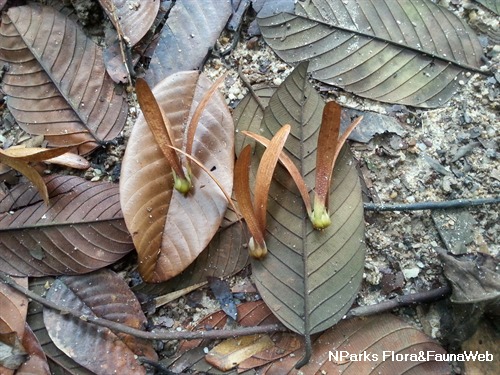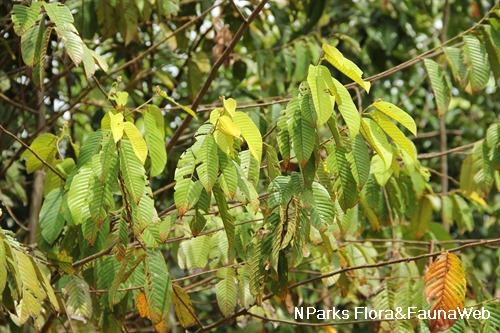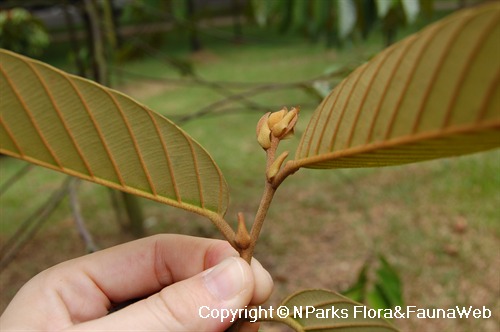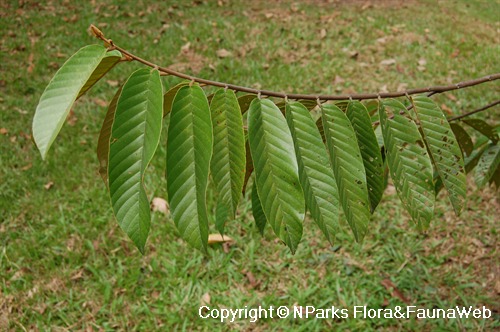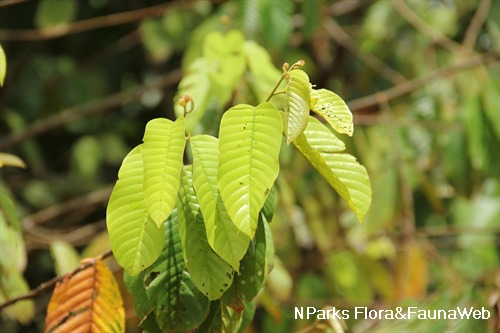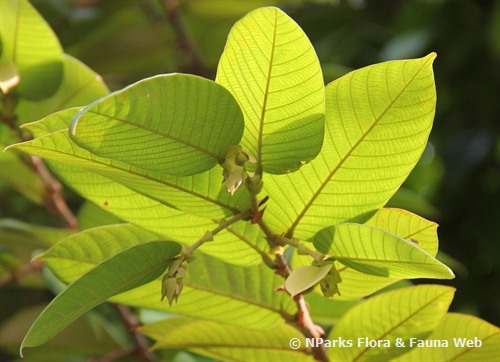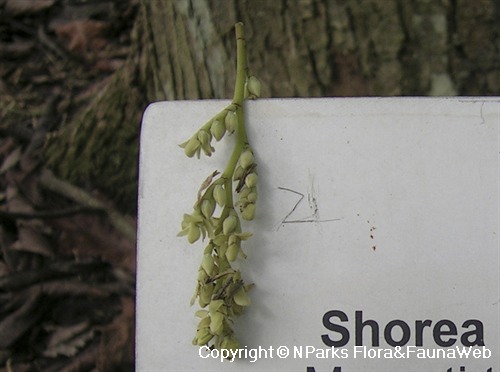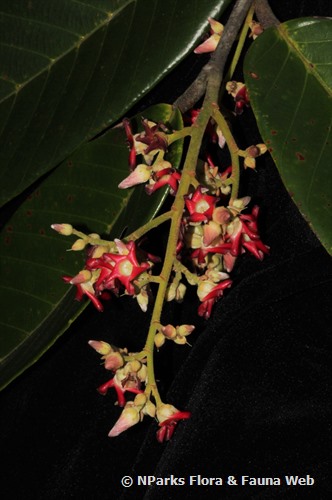.jpg)
Back
Rubroshorea leprosula (Miq.) P.S.Ashton & J.Heck.
| Family Name: | Dipterocarpaceae |
| Synonyms: | Shorea leprosula Miq. |
| Common Name: | Lampong, Lentang, Lentang Bari, Meranti Tembaga, Seraya Tembaga |
Name
Classifications and Characteristics
| Plant Division | Angiosperms (Flowering Seed Plants) (Dicotyledon) |
|---|---|
| Plant Growth Form | Tree (Big (>30m)) |
| Lifespan (in Singapore) | Perennial |
| Mode of Nutrition | Autotrophic |
| Plant Shape | Irregular |
| Maximum Height | 60 m |
Biogeography
| Native Distribution | Thailand, Peninsular Malaysia, Singapore, Sumatra, and Borneo |
|---|---|
| Native Habitat | Terrestrial (Primary Rainforest, Secondary Rainforest) |
| Preferred Climate Zone | Tropical |
| Local Conservation Status | Native to Singapore (Endangered (EN)) |
Description and Ethnobotany
| Growth Form | It is a tree, up to 60m tall. |
|---|---|
| Foliage | Its alternate, stalked leaves have leathery leaf blades that are oblong, oval or drop-shaped, pale pinkish brown above and brown, reddish or purplish below when dry, and 5.9-15 by 3.5-7.3 cm. |
| Flowers | Its flowering shoots are up to 14 cm long, and bear up to 12 pale yellow flowers that are about 11 mm wide. |
| Fruit | Its green-yellow-pink fruits consists of a nut that is 12-14 by 7-9 mm, with 3 longer wings that are 5-10 by 1-2 cm and 2 shorter wings that are 1.9-5.5 by 0.15-0.25 cm. |
| Habitat | It grows on clayey to sandy soil, limestone, in forests, and on alluvial and dry sites of hillsides and ridges up to 600 m altitude. It occurs locally in Bukit Timah Nature Reserve. |
| Associated Fauna | It has insect-pollinated flowers. It is the preferred local food plant for the caterpillars of several moth species. |
| Cultivation | It can be propagated by seed. |
| Etymology | The specific epithet leprosula is Latin for finely scaled, but the reference to which is unknown. |
| Ethnobotanical Uses | Timber & Products: It is a source of timber and resin. |
Landscaping Features
| Landscaping | It may be suitable for parks and also along streetscapes. |
|---|---|
| Landscape Uses | General, Suitable for Roadsides, Parks & Gardens |
Fauna, Pollination and Dispersal
| Fauna Pollination Dispersal Associated Fauna | Caterpillar Moth Food Plant |
|---|---|
| Pollination Method(s) | Biotic (Fauna) |
| Seed or Spore Dispersal | Abiotic |
Plant Care and Propagation
| Light Preference | Full Sun, Semi-Shade |
|---|---|
| Water Preference | Moderate Water |
| Plant Growth Rate | Moderate |
| Rootzone Tolerance | Moist Soils, Well-Drained Soils, Fertile Loamy Soils |
Foliar
| Mature Foliage Colour(s) | Green |
|---|---|
| Leaf Area Index (LAI) for Green Plot Ratio | 3.0 (Tree - Intermediate Canopy) |
Floral (Angiosperm)
| Flower & Plant Sexuality | Bisexual Flowers |
| Flower Colour(s) | Cream / Off-White, Yellow / Golden |
|---|---|
| Flower Grouping | Cluster / Inflorescence |
| Flower Location | Axillary |
| Flower Symmetry | Radial |
Fruit, Seed and Spore
| Mature Fruit Colour(s) | Brown, Green - Light Green, Pink, Yellow / Golden |
|---|---|
| Fruit Classification | Simple Fruit |
| Fruit Type | Indehiscent Dry Fruit , Nut / Nutlet |
References
| References | Ashton, P.S. & Heckenhauer, J. (2022). Tribe Shoreae (Dipterocarpaceae subfamily Dipterocarpoideae) finally dissected. Kew Bull. 77: 885–903. |
|---|
Image Repository
Others
| Master ID | 1831 |
|---|---|
| Species ID | 3124 |
| Flora Disclaimer | The information in this website has been compiled from reliable sources, such as reference works on medicinal plants. It is not a substitute for medical advice or treatment and NParks does not purport to provide any medical advice. Readers should always consult his/her physician before using or consuming a plant for medicinal purposes. |

.jpg)
.jpg)
.jpg)
